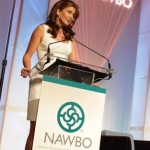Women Business Owners Rock the House in Louisville

Original appeared in the Huffington Post.
Women-owned businesses currently account for more than 30 percent of privately held companies in the U.S., with more on the rise as women are starting businesses at record rates. Moreover, women are running these businesses on their own terms, creating new standards that affect positive change. We are speaking out on issues of public policy, reducing our environmental footprint, redefining the office atmosphere and creating jobs that fuel the economy. Some of us are even taking our businesses global.
Although I’m an entrepreneur and small business owner now, this is a relatively new role for me. I worked internationally for MNCs for the first part of my career, but I have found this new role much more fulfilling on many levels. Besides running my own show, I value being part of something much greater than just me — a grassroots movement of women business owners and our community of supporters all dedicated to helping one another grow, thrive, give back and leave a legacy. This collective feminine buzz was palpable at the recent National Association of Women Business Owners (NAWBO) annual conference in Louisville last week — an event at which I was invited to speak.
This event is the largest of its kind in the United States, with more than 500 women business owners coming from across the U.S. representing industries and business of all sizes. This year’s theme, “Start Something,” celebrated the entrepreneurial, innovative and adventurous spirit of women business owners connecting and networking over the course of two days. (See pictures below!)
“I was so energized by the stories I heard from women business owners who started their companies — each under unique circumstances — and have pushed forward and grown these businesses despite a challenging few years,” says Diane Tomb, President & CEO of NAWBO. “These women are amazing and continue to innovate, advocate and accelerate for themselves and for all women entrepreneurs.”
Diane and her team put together a dynamic event with top-notch keynote and session speakers, including three amazing women who were honored with 2012 NAWBO Hall of Fame Awards. In turn, they each inspired us with their stories:
As a woman who reinvented herself from super model to super mogul, Kathy Ireland is an inspiration to many. She is chief designer and CEO of kathy ireland Worldwide, a business that grosses more than $1.9 billion in sales and whose brand sells in more than 50 countries around the world. In her uplifting keynote, she shared stories from her life as an 11-year old paper girl, a swimsuit model who was getting older and a woman starting her own business. She spoke passionately about the power of relationships and her belief that business leaders must use their position to advocate for issues we care about. She advised us to “make decisions that are intentional, not reactive” in our personal and professional lives.
 Katrina Markoff is owner, founder and chocolatier of Vosges Haut-Chocolat, which has made Inc. magazine’s list of 500 Fastest Growing Companies. In her talk, Katrina shared her road to success, challenges she faced along the way, and her creative process in taking an idea or inspiration and translating it into a new line of chocolate. She also shared how to taste chocolate to fully experience it.
Katrina Markoff is owner, founder and chocolatier of Vosges Haut-Chocolat, which has made Inc. magazine’s list of 500 Fastest Growing Companies. In her talk, Katrina shared her road to success, challenges she faced along the way, and her creative process in taking an idea or inspiration and translating it into a new line of chocolate. She also shared how to taste chocolate to fully experience it.
Karen Mills is Administrator of the Small Business Administration, who has served in President Obama’s Cabinet since January 2012 as a key member of the economic leadership team. NAWBO President  Diane Tomb sat down on stage for a Q&A with Karen, who spoke about the issues and the opportunities that women business owners and entrepreneurs face as they build innovative and successful companies and what the SBA is doing to support them. Forty years ago, women owned just 5 percent of small businesses; today, they own 30 percent. That equals a total of 7.8 million companies generating $1.2 trillion a year in sales.
Diane Tomb sat down on stage for a Q&A with Karen, who spoke about the issues and the opportunities that women business owners and entrepreneurs face as they build innovative and successful companies and what the SBA is doing to support them. Forty years ago, women owned just 5 percent of small businesses; today, they own 30 percent. That equals a total of 7.8 million companies generating $1.2 trillion a year in sales.
These keynotes were complemented by a rich mixture of breakout sessions over the course of two days. Topics included work-life integration, building a strong personal brand, using social media to your advantage, creating a powerful mentoring relationship, making public policy work for you, advancing women’s entrepreneurship, and taking your business global, the session that I led.
I love talking about all things global. And I’m thrilled to see that NAWBO and so many other conferences are beginning to include workshops and presentations on the global aspects of business and careers. It is a very good thing because global is everywhere, and we need to figure out how to deal with, manage it and profit from it. Despite 95 percent of the world’s consumers living outside our borders, not everyone thinks about her business as having the potential to be global, and indeed some don’t. But many think only global exports and international distribution, but how about tapping into global talent and resources along the supply chain, selling professional services, setting up R&D and/or manufacturing, and exporting an excellent idea and adapting it to a new market as an entrepreneurial venture. The global economy can help streamline all elements of the supply chain, creating profitable returns for small businesses that work creatively across markets. It’s up to you to figure out how.
In order to take your business global, you must think globally. It can be a daunting task to even think about doing business beyond our borders. In fact, culture and language barriers are the two reasons the vast majority of small business owners give for not going global. Ironically, and beneficially to women, we excel in cross-cultural situations (see my research on this topic conducted for my first book, Get Ahead By Going Abroad). Women are made for going global. Don’t let your inhibitions interfere with your exploration of the idea. Here are a few tips I offered in my NAWBO session:
- Do your research, including competitive analysis and market research, as well as look into the regulatory climate and banking and tax options of various countries. The International Finance Corporation (IFC) and World Bank publish a report annually on the ease of doing business by country.
- Take an investigative trip — as a business owner not a tourist — to get a handle on start-up costs, local culture and work ethic. Try to determine if you like the culture and could do business there. Compare it to another market if you can.
- Identify potential customers and clients based on demographics, industries and relevant infrastructure needs.
- Network and build relationships with like-minded global thinkers. Organize the list systematically so that if you have an opportunity to travel or receive a solicitation from a potential international partner, you’ll have a quick reference list. Networks are critical to success in going global beginning with the lead-up through global expansion.
Once you’ve done your leg work, seek out advisers who can help take your business global, including many available to you as a U.S. business owner. The Obama Administration has done an excellent job of addressing the needs of small business owners by revamping government resources so as to make them more relevant, efficient and accessible. The Export-Import Bank offers a wealth of information as part of its new Global Access initiative, as does BusinessUSA, a centralized, one-stop platform that makes it easier than ever for businesses to access services to help them grow and hire, housed under the Commerce Department. The Small Business Administration offers plenty of information on new financing, insurance, loans and tax incentives.
Plus there are many qualified companies and consultants who can help prepare you to — among other things — work successfully across cultures, conduct a successful market entry, and establish relationships with partners on the ground. The U.S. Chamber of Commerce site and local AmChams offer a wealth of information and an international network to tap into in hundreds of cities around the world. At the end of my presentation, women were swapping global contacts and starting something right in that room.
One of the reasons I love women’s conferences: We share information. We’re not only focused on growing the business and the bottom line, but we love to connect and share stories. You can learn so much about a woman’s business and her values when she shares her journey whether it’s a super model turned super mogul — or a global corporate exec turned entrepreneur.

Pingback: Women Business Owners Rock the House in Louisville | What I Wish I Had Known | Scoop.it
Pingback: Women Business Owners Rock the House in Louisville | Well Loved Woman | Scoop.it
Pingback: Women Business Owners Rock the House in Louisville | Trends in Tech | Scoop.it